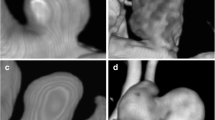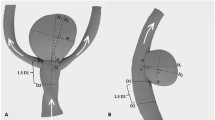Abstract
Purpose
There is a controversy concerning the risk of rupture of small intracranial aneurysms. We sought to determine the size and morphological features of ruptured intracranial aneurysms.
Material and Methods
The hospital files and images from all patients referred during one decade (2007–2016) to a specialized neurovascular center were retrospectively reviewed. Neck diameter, fundus depth and width as well as neck width based on catheter angiography were measured. Aneurysm morphology was classified as either regular, lobulated, irregular or fusiform.
Results
A total of 694 consecutive patients with aneurysmal subarachnoid hemorrhage (aSAH) were identified (65.9% female, median age 54.3 years). The anterior communicating artery (AcomA) was the most frequent location of ruptured aneurysms. The medians for aneurysm depth, width and neck diameter were 5 mm, 4.5 mm and 3 mm, respectively. A regular contour of the aneurysm sac was found in 19%.
Conclusion
The majority of aSAH are caused by small intracranial aneurysms. There is no safety margin in terms of small aneurysm size of regular shape without daughter aneurysms. Treatment should also be offered to patients with small, regularly shaped intracranial aneurysms, together with an empirical risk-benefit assessment.




Similar content being viewed by others
References
Vlak MH, Algra A, Brandenburg R, Rinkel GJ. Prevalence of unruptured intracranial aneurysms, with emphasis on sex, age, comorbidity, country, and time period: a systematic review and meta-analysis. Lancet Neurol. 2011;10:626–36.
Brisman JL, Song JK, Newell DW. Cerebral aneurysms. N Engl J Med. 2006;355:928–39.
Rinkel GJ, Djibuti M, Algra A, van Gijn J. Prevalence and risk of rupture of intracranial aneurysms. Stroke. 1998;29:251–6.
International Study of Unruptured Intracranial Aneurysms Investigators. Unruptured Intracranial aneurysms—risk of rupture and risks of surgical intervention. N Engl J Med. 1998;339:1725–33.
Wiebers DO. Unruptured intracranial aneurysms: natural history, clinical outcome, and risks of surgical and endovascular treatment. Lancet. 2003;362:103–10.
Tsutsumi K, Ueki K, Morita A, Kirino T. Risk of rupture from incidental cerebral aneurysms. J Neurosurg. 2000;93:550–3.
Juvela S, Porras M, Poussa K. Natural history of unruptured intracranial aneurysms: probability of and risk factors for aneurysm rupture. J Neurosurg. 2000;93:379–87.
Korja M, Lehto H, Juvela S. Lifelong rupture risk of intracranial aneurysms depends on risk factors. Stroke. 2014;45:1958–63.
Johnston SC, Selvin S, Gress DR. The burden, trends, and demographics of mortality from subarachnoid hemorrhage. Neurology. 1998;50:1413–8.
Suarez JI, Tarr RW, Selman WR. Aneurysmal subarachnoid hemorrhage. N Engl J Med. 2006;354:387–96.
Kreiter KT, Rosengart AJ, Claassen J, Fitzsimmons BF, Peery S, Du YE, Connolly ES, Mayer SA. Depressed mood and quality of life after subarachnoid hemorrhage. J Neurol Sci. 2013;335:64–71.
Steiner T, Juvela S, Unterberg A, Jung C, Forsting M, Rinkel G; European Stroke Organization. European Stroke Organization Guidelines for the management of Intracranial aneurysms and subarachnoid haemorrhage. Cerebrovasc Dis. 2013;35:93–112.
von Vogelsang AC, Burström K, Wengström Y, Svensson M, Forsberg C. Health-related quality of life 10 years after intracranial aneurysm rupture: a retrospective cohort study using EQ-5D. Neurosurgery. 2013;72:397–406.
Kassell NF, Torner JC. Size of intracranial aneurysms. Neurosurgery. 1983;12:291–7.
Yasui N, Suzuki A, Nishimura H, Suzuki K, Abe T. Long-term follow-up study of unruptured Intracranial aneurysms. Neurosurgery. 1997;40(6):1155–60. discussion 1159–60.
Osawa M, Hongo K, Tanaka Y, Nakamura Y, Kitazawa K, Kobayashi S. Results of direct surgery for aneurysmal subarachnoid haemorrhage: outcome of 2055 patients who underwent direct aneurysm surgery and profile of ruptured Intracranial aneurysms. Acta Neurochir (Wien). 2001;143:655–64.
Rahman M, Ogilvy CS, Zipfel GJ, Derdeyn CP, Siddiqui AH, Bulsara KR, Kim LJ, Riina HA, Mocco J, Hoh BL. Unruptured cerebral aneurysms do not shrink when they rupture: multicenter collaborative aneurysm study group. Neurosurgery. 2011;68:155–61.
Korja M, Kivisaari R, Rezai Jahromi B, Lehto H. Size and location of ruptured intracranial aneurysms: consecutive series of 1993 hospital-admitted patients. J Neurosurg. 2017;127(4):748–53.
van Donkelaar CE, Bakker NA, Veeger NJ, Uyttenboogaart M, Metzemaekers JD, Eshghi O, Mazuri A, Foumani M, Luijckx GJ, Groen RJ, van Dijk JM. Prediction of outcome after subarachnoid hemorrhage: timing of clinical assessment. J Neurosurg. 2017;126:52–9.
Lindgren AE, Koivisto T, Björkman J, von Und Zu Fraunberg M, Helin K, Jääskeläinen JE, Frösen J. Irregular shape of intracranial aneurysm indicates rupture risk irrespective of size in a population-based cohort. Stroke. 2016;47:1219–26.
Molyneux A, Kerr R, Stratton I, Sandercock P, Clarke M, Shrimpton J, Holman R; International Subarachnoid Aneurysm Trial (ISAT) Collaborative Group. International Subarachnoid Aneurysm Trial (ISAT) of neurosurgical clipping versus endovascular coiling in 2143 patients with ruptured intracranial aneurysms: a randomised trial. Lancet. 2002;360(9342):1267–74.
McDougall CG, Spetzler RF, Zabramski JM, Partovi S, Hills NK, Nakaji P, Albuquerque FC. The Barrow Ruptured Aneurysm Trial. J Neurosurg. 2012;116:135–44.
Wiebers DO, Whisnant JP, Sundt TM Jr, O’Fallon WM. The significance of unruptured intracranial saccular aneurysms. J Neurosurg. 1987;66:23–9.
McCormick WF, Acosta-Rua GJ. The size of intracranial saccular aneurysms. An autopsy study. J Neurosurg. 1970;33:422–7.
Yasui N, Magarisawa S, Suzuki A, Nishimura H, Okudera T, Abe T. Subarachnoid hemorrhage caused by previously diagnosed, previously unruptured Intracranial aneurysms: a retrospective analysis of 25 cases. Neurosurgery. 1996;39:1096–100; discussion 1100–1.
Abboud T, Rustom J, Bester M, Czorlich P, Vittorazzi E, Pinnschmidt HO, Westphal M, Regelsberger J. Morphology of ruptured and unruptured intracranial aneurysms. World Neurosurg. 2017;99:610–7.
Backes D, Vergouwen MD, Velthuis BK, van der Schaaf IC, Bor AS, Algra A, Rinkel GJ. Difference in aneurysm characteristics between ruptured and unruptured aneurysms in patients with multiple intracranial aneurysms. Stroke. 2014;45:1299–303.
Kashiwazaki D, Kuroda S; Sapporo SAH Study Group. Size ratio can highly predict rupture risk in intracranial small (<5 mm) aneurysms. Stroke. 2013;44(8):2169–73.
Huang ZQ, Meng ZH, Hou ZJ, Huang SQ, Chen JN, Yu H, Feng LJ, Wang Q, Li PA, Wen ZB. Geometric parameter analysis of ruptured and unruptured aneurysms in patients with symmetric bilateral intracranial aneurysms: a multicenter CT angiography study. AJNR Am J Neuroradiol. 2016;37:1413–7.
Xu T, Lin B, Liu S, Shao X, Xia N, Zhang Y, Xu H, Yang Y, Zhong M, Zhuge Q, Zhao B, Chen W. Larger size ratio associated with the rupture of very small (≤3 mm) anterior communicating artery aneurysms. J Neurointerv Surg. 2017;9(3):278–82.
Greving JP, Wermer MJ, Brown RD Jr, Morita A, Juvela S, Yonekura M, Ishibashi T, Torner JC, Nakayama T, Rinkel GJ, Algra A. Development of the PHASES score for prediction of risk of rupture of intracranial aneurysms: a pooled analysis of six prospective cohort studies. Lancet Neurol. 2014;13:59–66.
Macdonald RL. Aneurysm wall inflammation. J Neurosurg. 2013;120:70–2.
Pahl FH, de Oliveira MF, Ferreira NP, de Macedo LL, Brock RS, de Souza VC. Perianeurysmal edema as a predictive sign of aneurysmal rupture. J Neurosurg. 2014;121:1112–4.
Chalouhi N, Ali MS, Starke RM, Jabbour PM, Tjoumakaris SI, Gonzalez LF, Rosenwasser RH, Koch WJ, Dumont AS. Cigarette smoke and inflammation: role in cerebral aneurysm formation and rupture. Mediators Inflamm. 2012;2012:271582.
Chalouhi N, Ali MS, Jabbour PM, Tjoumakaris SI, Gonzalez LF, Rosenwasser RH, Koch WJ, Dumont AS. Biology of intracranial aneurysms: role of inflammation. J Cereb Blood Flow Metab. 2012;32:1659–76.
Frösen J, Piippo A, Paetau A, Kangasniemi M, Niemelä M, Hernesniemi J, Jääskeläinen J. Remodeling of saccular cerebral artery aneurysm wall is associated with rupture: histological analysis of 24 unruptured and 42 ruptured cases. Stroke. 2004;35:2287–93.
Hasan D, Chalouhi N, Jabbour P, Hashimoto T. Macrophage imbalance (M1 vs. M2) and upregulation of mast cells in wall of ruptured human cerebral aneurysms: preliminary results. J Neuroinflammation. 2012;9:222.
Hasan D, Chalouhi N, Jabbour P, Dumont AS, Kung DK, Magnotta VA, Young WL, Hashimoto T, Winn HR, Heistad D. Early change in ferumoxytol-enhanced magnetic resonance imaging signal suggests unstable human cerebral aneurysm. A pilot study. Stroke. 2012;43(12):3258–65.
Nagahata S, Nagahata M, Obara M, Kondo R, Minagawa N, Sato S, Sato S, Mouri W, Saito S, Kayama T. Wall enhancement of the intracranial aneurysms revealed by magnetic resonance vessel wall imaging using three-dimensional turbo spin-echo sequence with motion-sensitized driven-equilibrium: a sign of ruptured aneurysm? Clin Neuroradiol. 2016;26:277–83.
Edjlali M, Gentric JC, Régent-Rodriguez C, Trystram D, Hassen WB, Lion S, Nataf F, Raymond J, Wieben O, Turski P, Meder JF, Oppenheim C, Naggara O. Does aneurysmal wall enhancement on vessel wall MRI help to distinguish stable from unstable intracranial aneurysms? Stroke. 2014;45:3704–6.
Hu P, Yang Q, Wang DD, Guan SC, Zhang HQ. Wall enhancement on high-resolution magnetic resonance imaging may predict an unsteady state of an intracranial saccular aneurysm. Neuroradiology. 2016;58:979–85.
Acknowledgements
Hiltrud Niggemann performed the statistical analysis of the data.
Author information
Authors and Affiliations
Corresponding author
Ethics declarations
Conflict of interest
M. AlMatter, P. Bhogal, M. Aguilar Pérez, S. Schob, V. Hellstern, H. Bäzner, O. Ganslandt and H. Henkes declare that they have no competing interests in the context of this study.
Ethical standards
A study protocol was submitted to and approved by the responsible ethics committee (Ethik-Kommission bei der Landesärztekammer Baden-Württemberg).
Rights and permissions
About this article
Cite this article
AlMatter, M., Bhogal, P., Aguilar Pérez, M. et al. The Size of Ruptured Intracranial Aneurysms. Clin Neuroradiol 29, 125–133 (2019). https://doi.org/10.1007/s00062-017-0632-6
Received:
Accepted:
Published:
Issue Date:
DOI: https://doi.org/10.1007/s00062-017-0632-6




